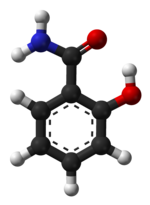Salicylamide
This is an old revision of this page, as edited by Entranced98 (talk | contribs) at 23:17, 3 December 2022 (+sd). The present address (URL) is a permanent link to this revision, which may differ significantly from the current revision.
 | |
 | |
| Clinical data | |
|---|---|
| MedlinePlus | a681004 |
| ATC code | |
| Pharmacokinetic data | |
| Excretion | Renal |
| Identifiers | |
| |
| CAS Number |
|
| PubChem CID | |
| DrugBank |
|
| ChemSpider |
|
| UNII | |
| ChEBI | |
| ChEMBL | |
| NIAID ChemDB | |
| CompTox Dashboard (EPA) | |
| ECHA InfoCard | 100.000.554 |
| Chemical and physical data | |
| Formula | C7H7NO2 |
| Molar mass | 137.138 g·mol−1 |
| 3D model (JSmol) | |
| Density | 1.33 g/cm3 |
| Solubility in water | Soluble in hot water, ether, alcohol, and chloroform. mg/mL (20 °C) |
| |
| |
| (verify) | |
Salicylamide (o-hydroxybenzamide or amide of salicyl) is a non-prescription drug with analgesic and antipyretic properties. Its medicinal uses are similar to those of aspirin.[1] Salicylamide is used in combination with both aspirin and caffeine in the over-the-counter pain remedy PainAid. It was also an ingredient in the over-the-counter pain remedy BC Powder but was removed from the formulation in 2009, and Excedrin used the ingredient from 1960 to 1980 in conjunction with aspirin, acetaminophen, and caffeine. It was used in later formulations of Vincent's powders in Australia as a substitute for phenacetin.

Derivatives
Derivatives of salicylamide include ethenzamide, labetalol, medroxalol, lopirin, otilonium, oxyclozanide, salicylanilide, niclosamide, and raclopride.
See also
References
- ^ "Salicylamide". Dictionary.com. Merriam-Webster's Medical Dictionary. Merriam-Webster, Inc. Retrieved December 31, 2006.
External links
| pyrazolones / pyrazolidines | |
|---|---|
| salicylates | |
| acetic acid derivatives and related substances | |
| oxicams | |
| propionic acid derivatives (profens) |
|
| n-arylanthranilic acids (fenamates) | |
| COX-2 inhibitors (coxibs) | |
| other | |
| NSAID combinations | |
Key: underline indicates initially developed first-in-class compound of specific group; #WHO-Essential Medicines; †withdrawn drugs; ‡veterinary use. | |
|
| Receptor (ligands) |
| ||||||||||||||||||||||||||
|---|---|---|---|---|---|---|---|---|---|---|---|---|---|---|---|---|---|---|---|---|---|---|---|---|---|---|---|
| Enzyme (inhibitors) |
| ||||||||||||||||||||||||||
| Others | |||||||||||||||||||||||||||
